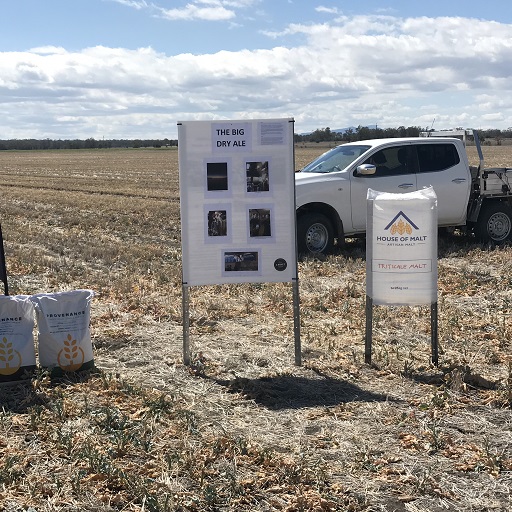
4 Pines brews with drought-resistant triticale

4 Pines has brewed two beers using a specially-bred malted triticale which is reportedly resistant to the effects of the drought which is currently affecting farmers across Australia.
The triticale (in this case a hybrid between durum wheat and rye) was developed with these drought-resistant qualities by researchers at the University of Sydney.
4 Pines’ head brewer Andrew Tweddell used it to brew 10 kegs of their Big Dry Ale with 20 per cent triticale malt, having been approached by Provenance Flour & Malt to give the hybrid grain a try.
“John [Campbell] from Provenance approached us. He’s an innovating human and always looking to improve every part of the supply chain, so he wanted to see how viable it is to use in beer,” Tweddell said.
“This strain of triticale that the University of Sydney has developed has a much better chance of growing in our worsening climate and can produce a greater yield for farmers.
“So if he can find new uses for this particular grain it means that more farmers can start growing it, which would be a huge win.
“For our part, we love to try new ingredients, new beers and new ways of doing things. If we find ingredients that help our environment and our community we’ll try it no matter the price.
“Once we’ve tested it we can see what the future might hold for it.”
John Campbell of Provenance Flour and Malt, which sources single origin and single varietal grains, said that triticales have previously been used as feed for livestock, but the success of the project opens up higher-value opportunities for farmers and another ingredient option for ever-innovating brewers.
“Triticale is an under-recognised and underutilised grain. As it’s a cross between durum wheat and rye it’s got some interesting characteristics in terms of the flavour profile and mouthfeel of beer.
“It’s languished at the bottom of the heap because it’s just been a feed grain and that’s why I’m interested in and excited by the beer we produced.”
He said that when it came to malting, it was only a small batch so it was floor malted by the maltsters at House of Malt in Ballarat, with only very minor differences to other grain malting.
4 Pines is already brewing a second beer with it, a Saison with 30 per cent malted triticale, but it’s options are limited by the amount grown and malted.
While the use of triticales in beer is not new, this hybrid grain was specifically bred by University of Sydney researchers with drought-resistant qualities to enable it to grow even in areas of NSW with highly acidic soils.

Jeremy Roake, a senior research assistant at the University of Sydney, said that the major benefit of the triticale was that it copes well with hostile soils.
“It’s good for nutrient deficient soils and can cope with toxicities that both wheat and barley cope with quite well, so it’s very good in the acid soils of Southern New South Wales.
“The main advantage would be the high yields of this particular line, more so than other triticales we’ve done in the past.
“[It also has] more of an extensive, dense root system, so it’s able to find more water within the soil.”
Whether it’s commercially viable in the long term is uncertain though, as it depends on the demands of the farmers. Brewing could be a high-value use for the triticale which benefits farmers particularly in drought-ridden areas, and Roake says, brewers too.
“If there’s a market for it it will be advantageous, farmers will get a better price per tonne for the grain, and the advantage for the brewer is that it’s something new to sell into the market,” he said.
When it comes to the flavour profile, Tweddell said that the triticale was a “surprisingly neutral” addition to the Big Dry Ale.
“I was expecting more nuttiness and spice, as is usually prevalent in rye. But that’s not bad news, because it doesn’t have a strong flavour means that we can use it for more types of beers which makes it more viable as an alternative to wheat,” he said.
“Another quality it has is that it produces very nice foam and gives the beer really good for head retention.
“From here we’ll investigate how viable it is as an alternative to wheat and that will determine how we use it. In the meantime we may order a bit more at a time and try it in more beer varieties in our Manly micro-brewery.”
Triticales are usually used for animal feed, but were initially intended to be used in breadmaking. This experiment hit a wall in the 1970s, but triticales are being brought back by scientists looking for rust and drought resistant varieties with high yields.
Provenance Malt & Flour is looking at reinvigorating the triticale process with the University of Sydney now that there is proof of concept with the triticale.
“It’s a matter of making sure we’ve got the right varieties available that have the best performance,” said Campbell.
“[This triticale] has a very exciting future.”





